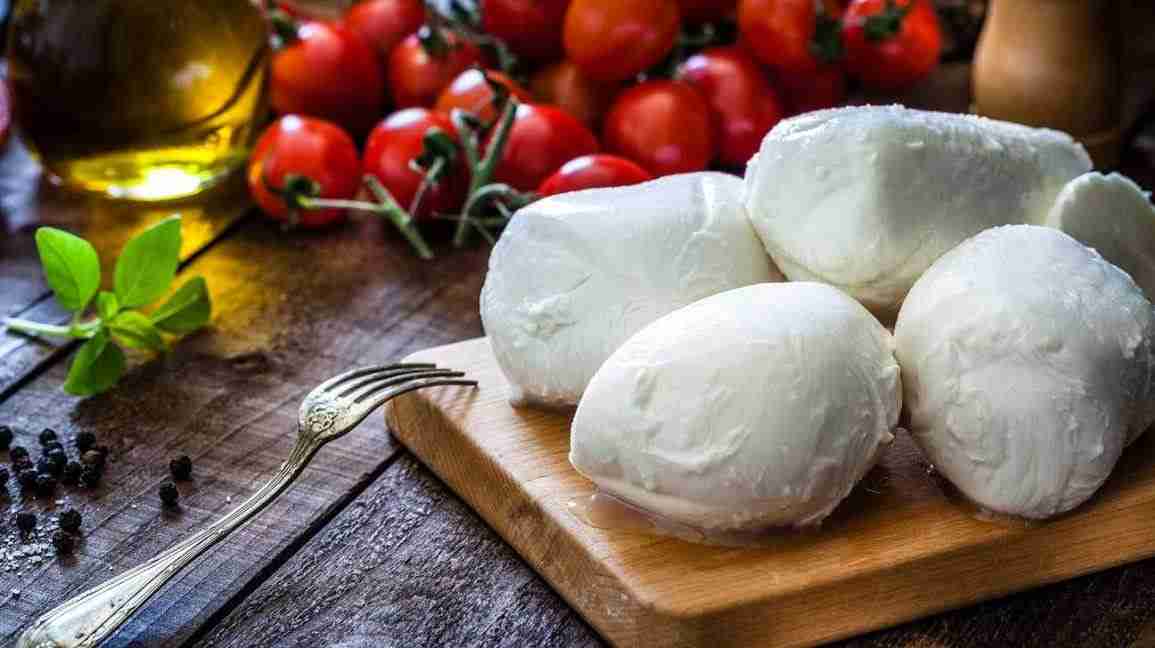Cheese is a dairy product that comes in hundreds of different textures and flavors.
It’s produced by adding acid or bacteria to milk from various farm animals, then aging or processing the solid parts of the milk.
The nutrition and taste of cheese depend on how it is produced and what milk is used.
Some people are concerned that cheese is high in fat, sodium, and calories. However, cheese is also an excellent source of protein, calcium, and several other nutrients.
Eating cheese may even aid weight loss and help prevent heart disease and osteoporosis. That said, some cheeses are healthier than others.
Here are 9 of the healthiest types of cheese.
Mozzarella is a soft, white cheese with high moisture content. It originated in Italy and is usually made from Italian buffalo or cow’s milk.
Mozzarella is lower in sodium and calories than most other cheeses. One ounce (28 grams) of full-fat mozzarella contains (
- Calories: 85
- Protein: 6 grams
- Fat: 6 grams
- Carbs: 1 gram
- Sodium: 176 mg — 7% of the Reference Daily Intake (RDI)
- Calcium: 14% of the RDI
Mozzarella also contains bacteria that act as probiotics, including strains of Lactobacillus casei and Lactobacillus fermentum (
Both animal and human studies show that these probiotics may improve gut health, promote immunity, and fight inflammation in your body (
One study in 1,072 older adults found that drinking 7 ounces (200 ml) per day of fermented dairy containing Lactobacillus fermentum for 3 monthssignificantly reduced the duration of respiratory infections, compared to not consuming the drink (
Therefore, dairy products like mozzarella that contain this probiotic may strengthen your immune system and help fight infections. However, more research is needed.
Mozzarella tastes delicious in Caprese salad — made with fresh tomatoes, basil, and balsamic vinegar — and can also be added to many recipes.
Summary Mozzarella is a soft cheese that’s lower in sodium and calories than most other cheeses. It also contains probiotics that may boost your immune system.
Blue cheese is made from cow, goat, or sheep’s milk that has been cured with cultures from the mold Penicillium (
It is typically white with blue or grey veins and spots. The mold used to create blue cheese gives it a distinctive odor and bold, tangy flavor.
Blue cheese is very nutritious and boasts more calcium than most other cheeses. One ounce (28 grams) of whole-milk blue cheese contains (
- Calories: 100
- Protein: 6 grams
- Fat: 8 grams
- Carbs: 1 gram
- Sodium: 380 mg — 16% of the RDI
- Calcium: 33% of the RDI
Since blue cheese is high in calcium, a nutrient necessary for optimal bone health, adding it to your diet may help prevent bone-related health issues.
In fact, adequate calcium intake is linked to a reduced risk of osteoporosis, which causes bones to become weak and brittle (
Blue cheese tastes great on top of burgers, pizzas, and salads made with spinach, nuts, and apples or pears.
Summary Blue cheese has distinctive blue or grey veins and a tangy taste. Loaded with calcium, it may promote bone health and help prevent osteoporosis.
Feta is a soft, salty, white cheese originally from Greece. It’s typically made from sheep’s or goat’s milk. Sheep’s milk gives feta a tangy and sharp taste, while goat’s feta is milder.
Since feta is packaged in brine to preserve freshness, it can be high in sodium. However, it is typically lower in calories than most other cheeses.
One ounce (28 grams) of full-fat feta cheese provides (
- Calories: 80
- Protein: 6 grams
- Fat: 5 grams
- Carbs: 1 gram
- Sodium: 370 mg — 16% of the RDI
- Calcium: 10% of the RDI
Feta, like all full-fat dairy, provides conjugated linoleic acid (CLA), which is associated with reduced body fat and improved body composition (
One study in 40 overweight adults found that taking 3.2 grams per day of a CLA supplement for 6 months significantly decreased body fat and prevented holiday weight gain, compared to a placebo (
Thus, eating CLA-containing foods like feta may help improve body composition. In fact, feta and other cheeses made from sheep’s milk typically have more CLA than other cheeses (17, 18).
However, research is limited and has mostly focused on CLA supplements.
To add feta cheese to your diet, try crumbling it over salads, adding it to eggs, or whipping it into a dip to eat with fresh vegetables.
Summary Feta is a Greek cheese that’s higher in salt but lower in calories than other cheeses. It may also contain higher amounts of CLA, a fatty acid linked to improved body composition.
Cottage cheese is a soft, white cheese made from the loose curds of cow’s milk. It’s thought to have originated in the United States.
Cottage cheese is much higher in protein than other cheeses. A 1/2-cup (110-gram) serving of full-fat cottage cheese provides (
- Calories: 120
- Protein: 12 grams
- Fat: 7 grams
- Carbs: 3 grams
- Sodium: 500 mg — 21% of the RDI
- Calcium: 10% of the RDI
Since cottage cheese is high in protein but low in calories, it is often recommended for weight loss.
Several studies indicate that eating high-protein foods like cottage cheese can increase feelings of fullness and help decrease overall calorie intake, which in turn may lead to weight loss (
A study in 30 healthy adults found that cottage cheese was just as filling as an omelet with a similar nutrient composition (
Thus, adding cottage cheese to your diet may help you feel fuller after meals and reduce your calorie intake.
It tastes great spread on toast, blended into smoothies, added to scrambled eggs, or used as the base for dips.
Summary Cottage cheese is a fresh, clumpy cheese that’s loaded with protein. Adding cottage cheese to your diet can help keep you full and may aid weight loss.
Ricotta is an Italian cheese made from the watery parts of cow, goat, sheep, or Italian water buffalo milk that are left over from making other cheeses. Ricotta has a creamy texture and is often described as a lighter version of cottage cheese.
A 1/2-cup (124-gram) serving of whole-milk ricotta contains (
- Calories: 180
- Protein: 12 grams
- Fat: 12 grams
- Carbs: 8 grams
- Sodium: 300 mg — 13% of the RDI
- Calcium: 20% of the RDI
The protein in ricotta cheese is mostly whey, a milk protein that contains all of the essential amino acids that humans need to obtain from food (
Whey is easily absorbed and may promote muscle growth, help lower blood pressure, and reduce high cholesterol levels (
One study in 70 overweight adults found that taking 54 grams of whey protein per day for 12 weeks lowered systolic blood pressure by 4% compared to baseline levels. However, this study focused on whey supplements rather than whey from dairy foods (
While ricotta may offer similar benefits, more research on whey from whole foods is needed.
Ricotta cheese tastes delicious in salads, scrambled eggs, pasta, and lasagna. It can also be used as a base for creamy dips or served with fruit for a sweet-and-salty snack.
Summary Ricotta is a creamy, white cheese that’s loaded with protein. The high-quality whey found in ricotta may promote muscle growth and help lower blood pressure.
Parmesan is a hard, aged cheese that has a gritty texture and a salty, nutty flavor. It’s made from raw, unpasteurized cow’s milk that’s aged for at least 12 months to kill harmful bacteria and produce a complex flavor (27).
The final product is loaded with nutrients. One ounce (28 grams) of Parmesan cheese provides (
- Calories: 110
- Protein: 10 grams
- Fat: 7 grams
- Carbs: 3 grams
- Sodium: 330 mg — 14% of the RDI
- Calcium: 34% of the RDI
A 1-ounce (28-gram) serving also contains close to 30% of the RDI for phosphorus (
Since Parmesan is rich in both calcium and phosphorus — nutrients that play a role in bone formation — it may promote bone health (
One study in around 5,000 healthy Korean adults found that higher dietary intakes of calcium and phosphorus were significantly associated with better bone mass in certain parts of the body — including the femur, the longest human bone (
Finally, since it’s aged for a long time, Parmesan is very low in lactose and can usually be tolerated by most people who have lactose intolerance (
Grated Parmesan can be added to pastas and pizzas. You can also sprinkle it on eggs or spread slices on a cheese board with fruit and nuts.
Summary Parmesan is a low-lactose cheese that’s high in calcium and phosphorus, which may promote bone health.
As the name suggests, Swiss cheese originated in Switzerland. This semi-hard cheese is normally made from cow’s milk and features a mild, nutty taste.
Its signature holes are formed by bacteria that release gases during the fermentation process.
One ounce (28 grams) of Swiss cheese made from whole milk contains (
- Calories: 111
- Protein: 8 grams
- Fat: 9 grams
- Carbs: less than 1 gram
- Sodium: 53 mg — 2% of the RDI
- Calcium: 25% of the RDI
Since it is lower in sodium and fat than most other cheeses, Swiss cheese is often recommended for anyone who needs to monitor their salt or fat intake, such as people with high blood pressure (
What’s more, research shows that Swiss cheese hosts various compounds that inhibit angiotensin-converting enzyme (ACE) (
ACE narrows blood vessels and raises blood pressure in your body — so compounds that stifle it may help lower blood pressure (
That said, most studies on the effects of Swiss cheese compounds on blood pressure have been isolated to test tubes. Human research is needed.
To incorporate Swiss cheese into your diet, you can eat it with fruit or add it to sandwiches, egg bakes, burgers, and French onion soup.
Summary Swiss cheese has less fat and sodium than most other cheeses and offers compounds that may help lower blood pressure. However, more research is needed.
Cheddar is a widely popular semi-hard cheese from England.
Made from cow’s milk that has been matured for several months, it can be white, off-white, or yellow. The taste of cheddar depends on the variety, ranging from mild to extra sharp.
One ounce (28 grams) of whole-milk cheddar contains (
- Calories: 115
- Protein: 7 grams
- Fat: 9 grams
- Carbs: 1 gram
- Sodium: 180 mg — 8% of the RDI
- Calcium: 20% of the RDI
In addition to being rich in protein and calcium, cheddar is a good source of vitamin K — especially vitamin K2 (
Vitamin K is important for heart and bone health. It prevents calcium from being deposited in the walls of your arteries and veins (
Inadequate vitamin K levels can cause calcium buildup, inhibiting blood flow and leading to an increased risk of blockages and heart disease (
To prevent calcium deposits, it’s important to get enough vitamin K from foods. As K2 from animal foods is better absorbed than K1 found in plants, K2 may be especially important for preventing heart disease (
In fact, one study in over 16,000 adult women linked higher vitamin K2 intake to a lower risk of developing heart disease over 8 years (
Eating cheddar is one way to increase your vitamin K2 intake. You can add it to charcuterie plates, vegetable dishes, burgers, and eggs.
Summary Cheddar is rich in vitamin K2, a nutrient that prevents calcium from building up in your arteries and veins. Getting enough K2 may decrease your risk of heart disease.
Goat cheese, also known as chèvre, is a tangy, soft cheese made from goat’s milk.
It’s available in several forms, including spreadable logs, crumbles, and varieties made to resemble Brie.
Goat cheese is highly nutritious, with 1 ounce (28 grams) providing (
- Calories: 75
- Protein: 5 grams
- Fat: 6 grams
- Carbs: 0 grams
- Sodium: 130 mg — 6% of the RDI
- Calcium: 4% of the RDI
In addition, goat’s milk has more medium-chain fatty acids than cow’s milk. These types of fat are rapidly absorbed in your body and less likely to be stored as fat (
Furthermore, goat cheese may be easier for some people to digest than cheese made from cow’s milk. This may be because goat’s milk is lower in lactose and contains different proteins.
In particular, goat cheese contains A2 casein, which may be less inflammatory and less likely to cause digestive discomfort than the A1 casein found in cow’s milk (
Crumbled goat cheese can be added to salads, pizzas, and eggs. What’s more, whipped goat cheese makes a delicious dip for fruit or vegetables.
Summary Goat cheese is lower in lactose and contains proteins that may be more easily digested than those in cheeses from cow’s milk.
Cheese is a widely consumed dairy product.
Most cheeses are a good source of protein and calcium, and some offer additional health benefits. In particular, certain cheeses may provide nutrients that promote gut health, aid weight loss, improve bone health, and decrease your risk of heart disease.
However, as some cheese can be high in sodium and/or fat, it’s still worth keeping an eye on your intake.
Overall, cheese can be a nutritious addition to a healthy, balanced diet.






